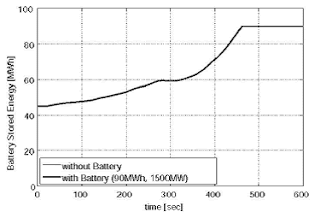ABSTRACT:
Recently,
a lot of distributed generations such as wind power generation are going to be installed
into power systems. However, the fluctuation of these generator outputs affects
the system frequency. Therefore, introduction of battery system to the power
system has been considered in order to suppress the fluctuation of the total
power output of the distributed generation. For frequency analysis, we use the interconnected
2-area power system model. It is assumed that a small control area with a large
penetration of wind power plants is interconnected into a large control area.
In this system, the tie line power fluctuation is very large as well as the
system frequency fluctuation. It is shown that the installed battery can suppress
these fluctuations and that the effect of battery on suppression of
fluctuations depends on the battery capacity. Then, the required battery capacity
for suppressing the tie line power deviation within a given level is calculated.
KEYWORDS:
1. Battery
2. Distributed
Generation
3. Frequency
4. Load
Frequency Control (LFC)
5. Power
System
6. Tie
Line Power
7. Wind
Power Generation
SOFTWARE: MATLAB/SIMULINK
BLOCK DIAGRAM:
Fig. 1. Battery system model.
EXPECTED SIMULATION RESULTS:
(a)
Tie line power flow
(b) system frequency (Area 2)
Fig.
2. Impact of LFC control method.
(a) Tie lie power flow
(b) System frequency (Area 2)
(c) Battery output
Fig.
3. Behaviors of tie line power flow, system frequency and battery
output
with/without battery (Kb = 0.5, Tb = 0.5).
(b) Battery stored energy
(c) Battery output
Fig.
4 Behaviors of tie line power and output and stored energy of battery (9OMWh, 1500MW)
CONCLUSION:
In
this paper, we have analyzed the impact of installed wind power generation and
battery on the system frequency and the tie line power. In 2-area power
systems, the tie line power fluctuation is remarkably large as well as the system
frequency fluctuation. It has been made clear that the installed battery can
suppress these fluctuations and that the effect of battery on suppression of
these fluctuations depends on battery capacity. If the stored energy of battery
reaches the full capacity, the battery output changes to zero suddenly and the large
fluctuation is caused. Therefore, the stored energy needs to be controlled
within the rated storage capacity. Based on this need, the required battery
capacity for suppressing the tie line power deviation within a reference level
has been calculated. If battery and LFC generator are controlled cooperatively,
installation of battery with a larger capacity makes it possible to decrease LFC
capacity of the conventional generators. In the near future, a new method to calculate
the optimal battery storage capacity (MWh) and the appropriate power converter capacity
(MW) for various kinds of wind power generation patterns and an effective
control method of the battery system for reducing the battery capacity and LFC capability
of the conventional power plants will be studied.
REFERENCES:
[1]
W. El-Khattam and M. M. A. Salama, "Distributed generation technologies,
definitions and benefits," Electric Power Systems Research, vol. 71, issue
2, pp. 1 19-128, Oct. 2004.
[2]
N. Jaleeli, L. S. VanSlyck, D. N. Ewart, L. H. Fink, and A. G. Hoffmann,
"Understanding automatic generation control," IEEE Trans. Power
Syst., vol. 7, pp. 1106-1122, Aug. 1992.
[3]
A. Murakami, A. Yokoyama, and Y. Tada, "Basic study on battery capacity evaluation
for load frequency control (LFC) in power system with a large penetration of
wind power generation," T. IEE Japan, vol. 126-B, no. 2, pp. 236-242, Feb.
2006. (in Japanese)
[4]
P. Kunder, "Power System Stability and Control, " McGraw-Hill, 1994.
[5]
A. J. Wood and B. F. Wollenberg, "Power Generation Operation and Control,"
2nd ed., Wiley, New York, 1966.








